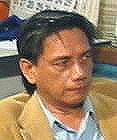Hounding anomalies in
rural settings – will they reach the new Malacañang?
 By CHITO DELA TORRE, delatorrechito@yahoo.com
By CHITO DELA TORRE, delatorrechito@yahoo.com
June
19, 2010
Time is now to monitor
government equipment that were given to barangays. Are they still
functional? Are they still owned by the barangay government, or by
the group of persons – mostly farmers – to whom they were entrusted?
Reports should be sent to the new Philippine president – erstwhile
Senator Benigno Simeon “Noynoy” Cojuangco Aquino III upon his
assumption of the presidency come June 30, 2010, on the first hour
after outgoing prez Gloria Arroyo seals her rule at exactly 12 high
noon of that day. Meanwhile, president-elect Noynoy should anticipate
that matters like these should be looked into with dispatch by himself
and his administration.
Catbalogan – the seat
of the provincial government – is the locus from where top decisions
are made as to what should be sent down to the barangays. It is also
where the decision makers often meet albeit its being the residence of
some of them. Here people mix, from the educated to the less educated
and the uneducated. Here they get information and clarifications on
issues that they bring back home, to their communities and families.
And it is also here that they reveal information about anomalous
transactions and illegal and unlawful activities, including abuses of
government officials and employees, obtaining in their own
communities. That’s why people here want to know what has gotten to
all those that have been sent to the rural areas in response to
requests or in implementation of decisions.
Sometime late in year
2003, then Second District representative Antonio Eduardo Nachura
caused to be delivered to selected barangays 8 rice threshers, each
worth P83,000 with a 9-horsepower Yanmar air-cooled engine to power
the equipment, for farmers to increase their palay production and
harvests. The Samar Agricultural and Fishery Multi-Purpose
Cooperative was tasked to monitor the use and care of those
P664,000-worth 9 threshers and see to it that those machines would
still be useable until today and for some years more.
Now, what happened to
those threshers?
Sta. Rita got one each
for barangays Anibongon, Binanalan, and Cadara(gan). Named to account
for them were punong barangay Jeracleo Cajipe, the Anibongon rice
producers association through Vedasto Lagario, and Cadara(gan) rice
producers association, in that order.
Basey got its shares
of the blessing for sitio Bangon of Canmanila thru Romualdo Echano,
Serum thru Rolando G. Jaingue, and Villa Aurora thru Meliton Lancanan.
Villareal received
only one for San Rafael, care of farmer Jorge Abainza.
Another listed
recipient barangay was “Villa Rosa” of Basey, with village chief
Sisinio O. Morabor as custodian. But wait. There is no barangay by
that name in Basey!
The custodian
recipients in Basey and Villareal are also supposed to render a
written report on what has been the effect of the threshers to the
palay harvesting work in their localities. There has been no
published account on any of the required report so far.
Never mind if the
recipient trustees of those rice threshers were believed to be
political supporters of the benefactor who was then a staunch and
highly credible political leader of Samar – because anyway my idol
Eddie could no longer reenter politics while he is an Associate
Justice or member of the Supreme Court to which he was appointed in
2007.
Word reached
Catbalogan that some custodians arrogated the ownership of the
threshers unto themselves and made money out of the rentals for the
use of the machines. The suspicion may not be true, but this can be
erased only if there will be a clear public accounting of the actual
use of both the machines and the proceeds from rentals for use
thereof. Having been given to the barangay units, or to an
association, the money earned from the rentals should have been turned
over to the barangay treasurer or the association treasurer and this
such treasurer should also keep a public record of his or her
accounting of the money. Where no money was made in payment, it was
in terms of “takal” of palay threshed.
A rice mill more than
a decade ago was acquired by a cooperative in an interior southern
barangay of Samar, from a bank loan obtained by the cooperative
operating in the village. For a short period of time, that rice mill
kept running and the proceeds went to the cooperative, as its
legitimate owner. Not long after that heyday, the village chieftain
claimed personal ownership of the equipment and since then kept for
his own personal use the financial gains from operating it, according
to complaining co-op members, mostly women, who until now continuously
fail to reclaim the rice mill. Could that village be Bulao in Basey?
A rural workers
association obtained a loan but an agriculturist, using technical
deception, became owner and user of the project for which the loan was
released, and now, the borrower members do not want to assume the
repayment obligations. They said, they never for once gained anything
from that loan and the project. This same agriculturist used a grant
for a fishing project that was supposed to be credited to the efforts
of a group of island fishermen. When fish harvest time came, the
islanders were told to back off. The agriculturist and those working
for him eventually became private owners of that fishing project.
Who in the
government now will look into these anomalies? Or, will these be left
alone? Something is wrong here, isn’t there? Will the new president
of the Philippines care to look into this as early as July, 2010?